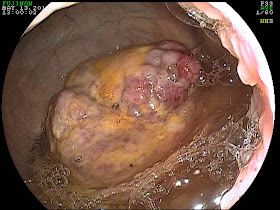A 12 year old gelding presented to PHD veterinary services for the complaint of "dribbling" urine and intermittent bouts of urinating blood (hematuria). The horse had been treated with a combination of antibiotics and steroids which had resulted in resolution of blood in the urine however he continued to dribble urine. On presentation the physical exam was normal other than evidence of chronic urinary incontinence based on the accumulation of dried urine over the dorsum of both hind limb pasterns. A rectal exam was performed and a softball-size mass was palpated within the urinary bladder.
 |
| Figure1 |
 |
| Figure 2 |
Cystoscopic exam noted several small soft tissue masses leading into the urinary bladder with evidence of active, mild hemorrhage (Figure 1). Once the urinary bladder was entered with the scope, a mass was noted lying underneath the urine that was present in the urinary bladder (Figure 2). The urine was evacuated through the scope revealing a large, soft tissue mass that was firmly attached to the ventral or bottom aspect of the urinary bladder (Figure 3 and 4).
 |
| Figure 3 |
 |
| Figure 4 |
Urinary bladder neoplasia or cancer is rare in horses. The most common common type reported in horses is squamous cell carcinoma and it commonly associated with hematuria. Other types of cancer include transitional cell carcinoma, lymphosarcoma, leimyosarcoma and fibrous polyps. Management of urinary bladder neoplasia in horses involves surgical resection and possible intra-lesional chemotherapy; however the prognosis is poor for long term survival. This horse will be managed with systemic anti-inflammatory medications to reduce local inflammation within the urinary bladder and the proximal urethra.




No comments:
Post a Comment